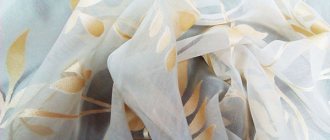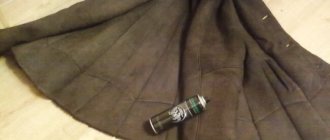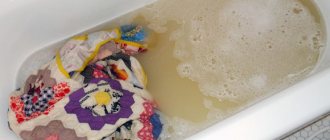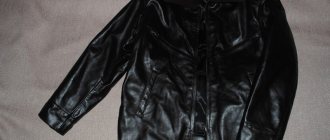Angelina
Some fabrics are not suitable for washing in a washing machine. In order not to spoil my favorite item or to refresh my underwear, I wash it by hand. With experience, I have developed rules that make the process simple and safe for clothes. I will share hand washing tips with you.
The washing container should be spacious so that it does not hinder the movement of your hands and the water does not splash out over the edge. Photo: l1.sl-love.ru
General rules for hand washing
Washing by hand involves carefully cleaning clothes from stains and dirt. Each type of tissue requires special conditions for this procedure.
Violation of the washing technique leads to loss of shape and deformation of things. Therefore, follow these recommendations:
- Do not leave dirty clothes in the laundry basket for a long time.
- Soak before washing. This procedure will simplify the removal of household stains.
- Before you start washing, you need to properly prepare your clothes. This will prevent tissue damage.
- Wash less soiled clothes first.
- Use a soft brush to remove grease.
- When washing, use a universal or special detergent. After adding the cleaner to the water, wait until the granules dissolve. Then you can immerse the soiled clothes.
- Start washing the product from problem areas. Lather the collar and sleeves thoroughly. Then scrub with a soft bristle brush.
- Use the water temperature specified on the manufacturer's label. Read the article about what icons indicate different modes on the labels.
- Rinse clothes in running water at least three times. Perform a final rinse with conditioner.
- Rinse items made from bright fabrics in a vinegar solution to fix the color.
- Soak clothes that shed in a saline solution.
- To soften the water, add a spoonful of baking soda to the washing powder.
- Wash wool items carefully, without stretching the sleeves, collar and shoulders.
- After washing, squeeze out the water with your hands. Or hang the product on hangers and a clothesline to drain water. For items made of thick fabric, you can use the spin function in the washing machine.
- Remove stains from fabric before washing. This will prevent dirt from penetrating deep into the fibers.
What cannot be washed in a washing machine?
Machine washing can cause damage to some products, as well as damage to household appliances. Let's look at what clothes are not recommended to be machine washed:
- Items made from delicate fabrics: silk, cashmere, wool and corduroy. After such washing, pellets, snags and small holes appear on the material.
- Clothes made of suede, natural and artificial leather. Intense rotation of the drum has a detrimental effect on the structure of the material.
- Feather pillows. Such products need to be dry cleaned. If the rules are followed, hand washing of the pen is allowed.
- Lingerie and clothes with lace. If it is not possible to wash by hand, use an automatic machine, only if you use a delicate mode and a special bag.
- Products that need to keep their shape: hats, caps, coats and jackets.
- Oversized clothes, blankets and rugs. A certain load is calculated for one washing cycle. Do not overload the washing machine. This will lead to poor quality washing and damage to the household appliance.
- Items that consist of different types of fabric and fine knitwear.
- Clothes with stains from gasoline, kerosene and machine oil. Washing them in an automatic machine can lead to irreversible consequences.
Preparing for hand washing
Before washing, you need to determine the location of the procedure. As a rule, they are washed in the bathroom or kitchen. To carry out the procedure, you will need two containers. Don't forget to stock up on the necessary tools: a soft brush and clothespins. Prepare detergent and rinse aid. Examine the fabric carefully. If there are traces of food, remove them. Only then proceed to the main wash. Be sure to wear rubber gloves to prevent chemicals from coming into contact with your hands.
Before placing a dirty item in the basin, check the pockets for loose change, bills, and other items. Pockets must be empty during washing. Remove jewelry and fur. Fasten buttons, zippers and Velcro. Turn the clothes inside out. Seal non-removable metal parts with tape or wrap them with plastic wrap.
Selecting the water temperature required for hand washing
The temperature depends on the type of material. As a rule, clothes are washed at the temperature specified by the manufacturer on the label. If your tag is lost, use the following guidelines. Clothes made of silk and wool are washed at a maximum temperature of 30 C°. White cotton products at 60-95 C°. Colored cotton clothes at 40 C°. Items made of synthetics and combined fabric at 30-50 C°. Maintaining temperature conditions will allow clothes to maintain their original appearance.
Washing rules[edit]
Washing symbols on textile labels[edit]
Template:Main Labels of textile products contain symbols that regulate the rules for their processing. For washing, this is a sign in the form of a basin with water GOST ISO 3758—2010 Textile products. Marking with care symbols. / ISO 3758:2005. Textiles — Care labeling code using symbols (IDT)..
Number
on the symbol indicates the maximum permissible water temperature for washing.
One horizontal line
at the bottom of the symbol means gentle washing conditions.
The amount of laundry in the washing machine should not exceed approximately 2/3 of the maximum permissible value, the mechanical force (torsion) of the machine should be reduced. Spin in the machine at a reduced number of revolutions per minute and spin duration. Hand squeeze gently. Two horizontal lines
at the bottom of the symbol indicate particularly gentle washing conditions. The amount of laundry in the machine should not exceed approximately 1/3 of the maximum permissible value; the mechanical force (torsion) of the machine should be significantly reduced. Spin in the machine at a significantly reduced number of revolutions per minute and spin duration. Manually squeeze very carefully, without twisting, or do not squeeze.
| 80px | Normal wash at water temperature up to 95 °C (boiling allowed) |
| 80px | Normal wash at water temperatures up to 60 °C |
| 80px | Normal wash at water temperatures up to 30 °C |
| 80px | Gentle wash at water temperatures up to 30 °C |
| 80px | Particularly gentle washing at water temperatures up to 30 °C |
| 80px | Hand wash at water temperatures up to 40 °C. Do not rub the product. Squeeze gently, without twistingTemplate:Cite web |
| 80px | Washing is prohibited |
Preparation[edit]
First of all, you need to prepare things for washing.
- Remove everything from your clothing pockets (keys, money, notes, etc.).
- Turn the bed linen inside out and remove any debris that has accumulated in the corners.
- Straighten the cuffs on the sleeves of shirts.
- Turn trousers, skirts, knitwear, socks, tights, stockings inside out. This way they retain their color longer.
- Unfasten the buttons.
- Fasten zippers, buttons and hooks.
- Tie laces and ribbons.
- If necessary, treat stains with stain remover.
Sorting[edit]
Sort things by composition and type of fabric used, as well as by color.
To begin with, pay attention to the labels and the composition of the fabric. Clothes that require more delicate washing with special requirements for temperature and/or reagents are set aside separately; lightly soiled items made from coarser fabrics that are compatible in color and washing conditions can be added to them.
To avoid staining of some fabrics by others due to shedding, wash white items separately, light items separately, and dark items separately. Separately, it is also recommended to wash heavily faded and heavily soiled clothing (however, to refresh the color, you can wash a dark, heavily faded item together with other items of the same color). It is not recommended to wash colored items at too high a temperature.
Heavily soiled items made from not too delicate fabrics are best washed with soaking.
Items that require boiling (or machine washing at 95 degrees Celsius) for disinfection are also washed separately.
Washing requirements for different fabrics[edit]
According to the conditions for washing, fabrics can be divided into the following groups:
- Natural plant fabrics: cotton, linen, hemp, jute. Can be washed at almost any temperature and with almost any reagents.
- Natural fabrics of animal origin: wool, silk, as well as polyamides: nylon, nylon. Such fabrics should be washed carefully, at a temperature no higher than 50-60 Template: Degrees Celsius. They cannot be washed with enzymes that decompose proteins (protease, keratinase), chemical bleaches or alkaline salts cannot be used.
- Artificial fibers (viscose). Wash at a temperature not exceeding 30 Template: Degrees Celsius, wring out carefully, without twisting.
- Polyesters: lavsan (terylene); polyacrylates: acrylic; polyurethanes: lycra. Wash at a temperature no higher than 50-60 Template: Degree Celsius. You should absolutely not wash with alkaline salts, including even laundry soap (it contains sodium carbonate), and you should not use chlorine-based bleaches.
- Mixed fabrics (Dacron + wool, Dacron + cotton, nylon + lycra, etc.). Observe the restrictions corresponding to each fiber type.
Selection of hand wash products
For washing, choose special products based on the color and type of fabric: for white, colored, knitted, cotton, wool and synthetic fabrics. Products marked “For hand washing” are less aggressive for the skin of your hands. They foam more, which helps remove dirt quickly. For washing delicate fabrics, it is better to use gel products. The liquid product, compared to the powder, is completely dissolved in cool water. If it is not available, replace it with regular hair shampoo.
Stain removers are used to remove stains. Their choice also depends on the type and color of the material. Vanish, Amway and Antipyatin anti-stain products are very popular. The substance is applied to the stain. After 20-30 minutes, wash off with water. Then add a small amount to the basin when washing by hand. The dosage of the stain remover is indicated on the packaging. Give preference to products without chlorine, as it destroys fabric fibers. To remove stains, you can use traditional methods: a solution of salt, peroxide, soda, vinegar or ammonia. Rinse aids are used to soften the material of clothing.
Buy detergents from trusted manufacturers. Washing powders and gels from Procter & Gamble and Henkel are in demand among buyers. These include: “Persil”, “Ariel”, “Tide”, “Perwoll” and others. To wash children's clothes, use more natural cleaners: “Eared Nanny”, “Our Mother”, “Umka” and baby soap. Laundry soap is no less effective at removing stains and dirt. In addition, it will soften the water.
To wash children's clothes (and if you are prone to allergies), you can use a homemade cleaner. Take 50 grams of soap root and 1.5 liters of warm water. Leave the solution for a day. During the washing process, use 10 ml. products for 3 liters. water. To prepare the rinse, you will need a spoon of acetic acid, a glass of water and 5 drops of lavender oil.
How to quickly and easily wash by hand
Washing by hand is not as difficult as it may seem to inexperienced housewives. To do this, you just need to prepare two bowls of water and stock up on washing powder:
- Pour warm water into one bowl and dissolve the powder in it. Do it correctly: there should be no soap flakes left in the water, otherwise things may become covered with streaks. Important: liquid detergent is best suited for hand washing.
- Gently place the clothing in the soapy water. Allow it to get thoroughly wet - this may take 5-10 minutes. If you start hand washing earlier, the fabric simply will not wash.
- Rub the most contaminated areas with your hands. You can use a clothes brush.
- If things aren't too dirty, just give them a good stir from top to bottom and in a circle. Make sure that they do not get tied into knots or get tangled with each other. To prevent the skin on your hands from being damaged by the powder, use a stick or wash with gloves.
- Now take each item separately and rinse it in cool water one by one.
- Gently squeeze out excess water. For delicate fabrics it is better to use a towel.
- Hang clothes on a line to dry. Wool and cashmere are laid out to dry on the floor, with a clean sheet underneath.
This method will allow you to wash any type of clothing. The only exception is socks: they are easiest to wash by hand if you put them on your hands and wash them under running water and soap. Underwear also has its own secrets.
Hand washing process
Hand washing consists of the following steps:
- Place the washing container on a stool or in the bathtub.
- Fill the bowl with water at a temperature appropriate for the type of fabric.
- Add detergent. Then a spoonful of soda to soften the water.
- Immerse clothing in the soapy solution for 30-45 minutes.
- After soaking, rub the items with your hands to remove dirt. You can use a soft brush.
- Rinse clothes thoroughly with warm, then cool water.
- Squeeze out the water without stretching the fabric. Do not use the spin cycle on delicate fabrics. They may shrink. Hang them on a rope above the bathtub to drain the water. Remove excess moisture with a terry towel.
- You need to dry your clothes outside. Or in a ventilated room. For jackets and blazers, use coat hangers or mannequins. Do not dry synthetic fabric in the sun as it tends to fade. Woolen sweaters and hats should be dried horizontally.
Hand washing will help maintain the original appearance of the clothes. Use the tips described in the article. If you have any questions on the topic, write in the comments.
What clothes should be washed by hand?
There are various items that can be washed by hand.
Shawls
Most people wash handkerchiefs not in automatic machines, but with their hands. To begin with, they are thoroughly cleared of dust and debris, and then cleaned with a brush. The scarf is then placed in a soapy solution to soak. After half an hour, it is washed and rinsed.
Scarves
It is recommended to wash scarves by hand, as this is quite easy to do. To remove stains from them, just place them in a bowl of hot water or soapy water for half an hour. If the stain on the scarf has become embedded in the fabric, you can use a brush.
Natural silk blouses
Silk products are very capricious, and therefore they must be washed carefully. First, the water is boiled, after which it is cooled to thirty-five degrees. Then add a little shampoo with laundry soap or powder to the water. When the mixture in the basin becomes homogeneous, you can start washing.
Sweatshirts, sweaters, pullovers made of wool
It is also contraindicated to wash woolen products in boiling water, and therefore it is better to use lukewarm water heated to forty degrees. Washing powder or gel is added to it to clean woolen clothes.
Cashmere products
Before washing, the container is filled with warm liquid, which is mixed with detergents. Then the dirty cashmere items are dipped into the water and soaked for 20-30 minutes. Cashmere fabric should not be rubbed to prevent it from becoming deformed.
Therefore, during washing you will have to carefully squeeze and release it.
Delicate lingerie and lace
Delicate lace underwear needs proper care. To remove stains from it, you need to fill a basin with warm water and washing powder. Then the laundry is soaked in it for about 10-15 minutes. Rinse to remove remaining traces of dirt.











